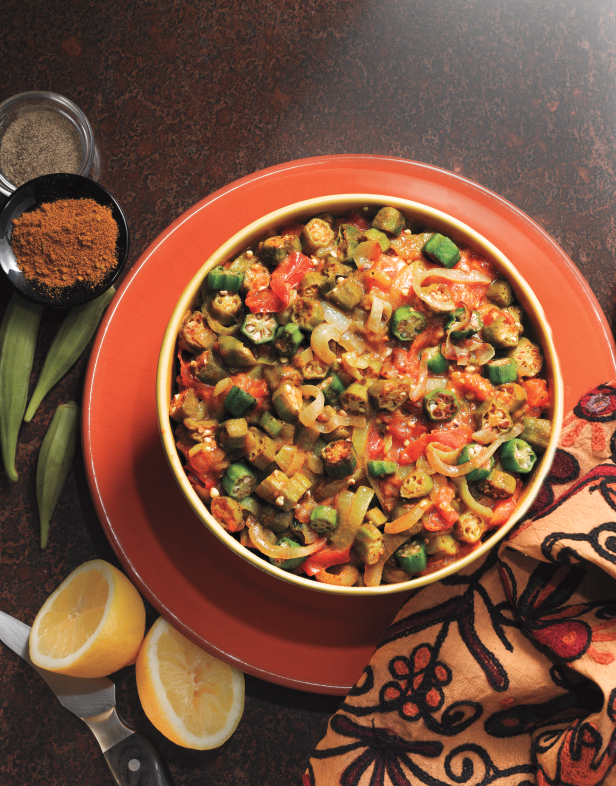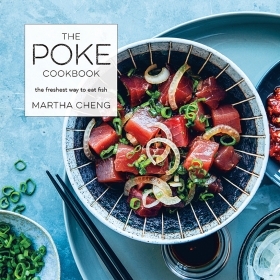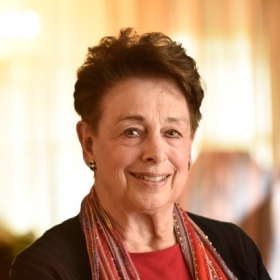We all have foods—whether sweet or savory, spicy or mild—that are the culinary equivalent of a warm hug. The recipes here come from five alums who return to these foods over and over, at the request of family and friends, or just to please themselves.

In the last year, as the pandemic has raged on, as we have experienced fires, floods, and political turmoil, most of us have been going out a lot less and cooking a lot more. There is often something soothing about the rhythms of meal preparation, especially when you have time to do it. The peeling, chopping, stirring bring a sort of comfort. So do the aromas wafting from the kitchen: bread baking, meat roasting, a pot of chai on the stove. Comfort can come from an elaborate, multicourse meal or an impromptu snack eaten over the sink. (Aficionados swear that’s the only sane way to consume a sandwich made with the summer’s first ripe tomatoes.)
We all have foods—whether sweet or savory, spicy or mild—that are the culinary equivalent of a warm hug. The recipes here come from five alums who return to these foods over and over, at the request of family and friends, or just to please themselves. When they’re served, they provide sustenance for the stomach and the soul.
Kumari Devarajan ’17
Los Angeles
Kumari Devarajan ’17 usually lives in Los Angeles, where she is a producer for NPR’s Code Switch team (and, full disclosure, sometimes produces my radio pieces). But when I spoke to her, she was in Washington, D.C., at her parents’ home, working remotely for a few months.
Kumari did not grow up cooking because she didn’t have to: “I was very lucky because my dad loves cooking, and so we always had home-cooked meals, at least four out of five weeknights,” she says. Her parents were both economists at the World Bank. Her mother doesn’t cook, but she is a great baker. “In my house, all the cookie jars always were full,” Kumari says. “Whenever there was a bake sale or I had to bring anything for school, I didn’t even have to ask twice.”
She didn’t start cooking for herself “until after I graduated from college and was living on my own and just kind of had to start from scratch. I think what helps is I know what a good meal is supposed to taste like and smell like because I grew up with it. So that kind of motivated me to try to get good at it. My staples [are] pad thai or roasted green beans—and I like spending a whole day making Bolognese sauce.”
Kumari’s dad is a Tamil Sri Lankan, and when her paternal grandparents lived in the States for several years, her paatti (grandmother) missed her homeland and tried to replicate some of her favorite dishes with approximate equivalents from local grocery stores. She even wrote a cookbook, Curry in a Hurry, for others who wanted to try Sri Lankan food. Some of the ingredients, like coconut milk, are easily found in most grocery stores today, but back then, they were considered exotic and hard to find, so she substituted evaporated or dried milk. Making curry powder from scratch is common in much of South Asia, but for American cooks, commercial curry powder was probably a safer bet. Kumari’s dad (now a university professor) says the page with his mother’s curried okra recipe is “the most stained, because it was the most used.” It’s simple and quick and, Kumari says, is often served alongside a curried omelet for a light, satisfying dinner.
[substory:1]
Paula Penn-Nabrit ’76
Columbus, Ohio
If you’re friends with Paula Penn-Nabrit ’76 on Facebook, you’ll see posts showing gorgeous baked goods, from bread to a pound cake made from her mother-in-law’s coveted recipe. There are pictures of glass jars filled with bounty from the community garden she established in memory of her late husband, Charles Madison Nabrit III, and nutritious drinks for everything that ails you. Paula says her interest in food started in childhood: “Everything revolved around food.”
She grew up in a deeply faithful family. “We come from the Apostolic Pentecostal tradition. And so what that means is you don’t drink, you don’t smoke, you don’t go to a movie. You don’t play cards. You don’t go to dances.” Given those parameters, “food is a form of entertainment. It’s also what you do when something bad happens. If somebody has a death in the community, we show up with food. It’s what you do to celebrate. When something wonderful happens, we eat.”
Some of her fondest memories center around going food shopping on Saturdays at Columbus, Ohio’s North Market with her father. She’d listen to his conversation with the butcher, the greengrocer as they debated the merits of this chop, that pear. “So, food was never a casual thing.”
As important as food was, Paula didn’t cook when she lived at home. Her mother worked and had someone in daily to keep house, watch Paula and her sisters, and start dinner for the family. When Paula married Charles, her new husband drew her into the kitchen. “He really taught me how to cook, and it was always fun for us to do together. And we continued that when we had our kids. All my kids can cook—and they’re really good cooks,” she says proudly.
One of Charles’ favorite foods was greens. “I grew up in Ohio. Turnips and other root vegetables were a big thing in my family,” she explains. Charles was from Memphis, “where greens were a regular part of the cuisine.” So she learned to cook greens to please her husband and discovered she loved them, too. “Greens are comforting because they are something that I associate with him. It was also comforting because when our children were babies, I would make greens and then give them the pot liquor [liquid].” Her boys were 4 and 5, she laughs, “before they realized not all juice is green!”
[substory:2]
Margaret Hathaway ’98
Gray, Maine
Margaret Hathaway ’98 grew up in Kansas with a divorced working mother. “My mom is an English professor, and cooking was not something that she was super comfortable [with] or all that interested in,” she remembers. “She’s great at making granola and bread, but she’s just not much of an experimental cook. My dad had always done all the cooking.”
Her mother mostly made vegetarian dishes from the vegetarian bible at the time, The Moosewood Cookbook, so Margaret ate vegetarian, too. She remained a vegetarian while at Wellesley, but that changed when she was awarded a Fulbright fellowship to Tunisia. In North Africa, meat was a precious commodity, she recalls. “It just felt like it was going to be disrespectful to not eat meat if it was offered to me. And so I started eating meat there. And actually, the first time I bought a chicken to cook was at a live market in the medina (the main marketplace).”
After she graduated, Hathaway and her then-boyfriend, Karl Schatz, got married and settled in New York City. But Karl wanted to return home to Maine, and both of them had a long-held desire to raise dairy goats, so they packed up and bought a small farm. They’re raising three daughters, and they farm sustainably. All the girls have become cooks. And one of their favorite dishes is Margaret’s roast chicken, which they now make themselves.
“It’s a really simple roasted chicken, stuffed with whatever herbs I have to hand this time of year,” she explains. “It’s doused with some wine. And usually I cook some potatoes underneath.” The dish is comforting “because it takes a while to cook. The house starts to be perfumed. It’s one of those dishes that when I’m making it, I’m relaxed because it doesn’t take a lot of work.” And there are often leftovers: “You can make stock with the bones. So there’s comfort that there are meals to come as well.” Next: chicken noodle soup?
[substory:3]
Luisa Bonillas ’94 and Ariana Gonzales-Bonillas ’18
Chandler, Ariz.
If this pandemic has had a silver lining, it’s that some families have gotten to spend more time together. Luisa Bonillas ’94, whose alumna daughter is currently working remotely from the family home, says they are mostly eating takeout at the moment “because we’re trying to support small businesses, to keep them afloat.” One thing that they don’t outsource, though, is dessert. And during this anxious time, Luisa finds herself turning to an old family recipe: a cinnamon-scented rice pudding that’s been passed down through the generations.
“My great-grandmother, my mom’s grandmother, is the one who taught my grandmother, and I don’t know where my great-grandmother learned it,” she says. “My mom grew up in this small little town in Mexico, and her mom, every afternoon, would bake something or make some special treat.” Arroz con leche was a family favorite. “They actually had it pretty often, but they liked it with evaporated milk. But because they lived in this tiny little pueblo, they didn’t always have evaporated milk, so they just used milk straight from the cow—literally straight from the cow!” When her grandmother moved to southern Arizona, life got busier, and arroz con leche was made less often. But Luisa recalls standing by the stove as her grandmother stirred the creamy mixture, and the scent of cinnamon filled the kitchen.
I wondered if either mother or daughter had ever tried commercial rice pudding. Polite pause. “We have tried it,” Ariana says carefully. The verdict? “Not good at all,” Luisa says firmly.
Luisa’s family recipe calls for Mexican cinnamon, which you can find in many Latino grocery stores. “It doesn’t come prepackaged and they sell it by the pound,” she says. It’s sweet and spicy and very fragrant. “And we use Mexican vanilla. It just makes the house smell so good, I love it.”
The dish is time-consuming: Luisa says you have to keep stirring the rice mixture as it cooks, so it doesn’t scorch. But that gives her time to slow down, think, and settle into herself a bit: “I have to dedicate time to doing this.”
And all that work, is it worth it? Definitely, Ariana says. “The time, and the memories and the smell—are all comfort.”
Which is exactly the point of comfort food.
[substory:4]
Karen Grigsby Bates ’73 is the senior correspondent for Code Switch, NPR’s popular podcast that covers race and identity. One of her favorite comfort food memories comes from Wellesley: “afternoon tea before the fireplace in Beebe.”






